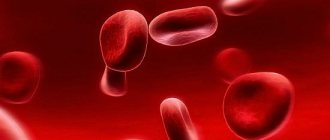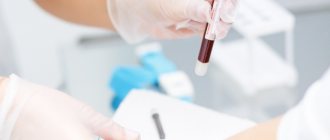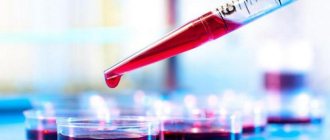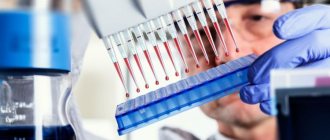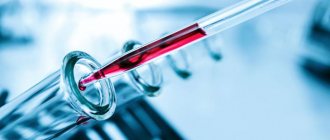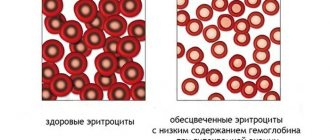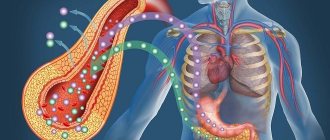Leukemia is a serious oncological disease characterized by malignant damage to blood cells. In adults, the main symptoms of the disease are dysfunction of the immune system, increased fatigue, and slow regeneration of epithelial cells.
In medical terminology, leukemia is also found under the names: leukemia, leukemia. To confirm the diagnosis, a biochemical analysis of venous blood is used.
In modern hematology, leukemia is usually classified as a large number of blood diseases associated with the pathological state of the cellular apparatus responsible for the synthesis of leukocytes.
The main characterizing features of leukemia include the presence of malignant clones, which in most cases are produced by immature hematopoietic bone marrow cells. Unlike other pathologies of the hematopoietic system, leukemia belongs to the category of neoplastic diseases.
The progression of leukemia is due to the fact that the malignant clone continues uncontrolled cell division, increasing the number of mutated cells. In this regard, the blood of a sick person gradually loses its physiological functions.
This leads to disruption of the functioning of internal organs and all body systems. According to recent scientific research, leukemia can occur in acute, chronic and latent forms. The latter type of disease can develop over 50-60 years.
How it manifests itself
Leukemia symptoms almost always disguise themselves as a cold infection.
A person begins to be more often attacked by viruses and bacteria, which is expressed in different ways, ranging from elevated body temperature to severe weakness. All this is associated with dysfunction of leukocytes, which undergo mutations. They become inactive, therefore they are not able to fully fight pathogenic microorganisms coming from the outside. The following signs of leukemia in adults are pathognomic for the acute stage of the disease:
- General malaise and severe weakness.
- Frequent headaches.
- Vomit.
- Impaired consciousness.
- Muscle atony, uncontrolled movements of the limbs.
- Involuntary muscle contractions.
Other symptoms of acute leukemia: lack of appetite, sudden weight loss, abdominal pain due to an increase in the size of the spleen and liver. As the pathology progresses, brain symptoms intensify, vision begins to suffer, disorders in the functioning of the vestibular apparatus are observed, severe shortness of breath and paroxysmal cough occur.
Symptoms of leukemia in children in the acute stage are similar to similar manifestations of the disease in adults. They lose their appetite, lose weight, experience vomiting, and headaches. Convulsive seizures occur periodically. Treatment with antibacterial drugs does not bring the desired effect. The child has long and severely more viral infections.
Subcutaneous hemorrhages, characteristic of this disease, occur due to a drop in platelet levels. Patients have a hard time with even minor wounds and scratches, since the blood takes longer to clot than in healthy people. Subcutaneous hemorrhages have the appearance of a petechial rash.
Signs of leukemia in children and adults during the acute course of the disease progress at a high rate. The chronic form proceeds much more slowly and behaves more hidden. In this case, the stages of leukemia pass almost unnoticed by the patient. He periodically suffers from viral infections, his gums bleed more frequently, and he may experience abdominal pain as his spleen increases in size. Gradually, a person loses weight, but this does not happen as sharply as in the acute form of the disease.
Enlarged lymph nodes are observed near the organ in which the most mutated cells accumulate. This could be the liver, kidneys, spleen, lungs, heart. Lymph nodes become painful, which forces a person to consult a specialist.
Depending on the specific type of blood cancer, its symptoms may differ slightly. For example, hairy cell leukemia very slowly leads to splenomegaly. Chronic myeloblastic leukemia does not manifest itself in any way for a long time, except that the patient’s sweating increases at night. At the same time, the level of leukocytes in the blood can go off scale. A similar clinical picture is valid for chronic lymphoblastic leukemia.
So, the symptoms characteristic of this type of cancer, regardless of its form: frequent infections, general malaise, fever and weight loss.
Acute form
The most common form of acute leukemia in adults is acute myeloid leukemia (AML). The prevalence of this disease is 1 in 100,000 people over 30 years of age and 1 in 10,000 people over 65 years of age. The causes of acute myeloid leukemia in adults are not fully understood.
Symptoms of acute leukemia in adults:
- Symptoms of influenza are fever, weakness, bone pain, symptoms of inflammation of the respiratory tract.
- Symptoms of the so-called purpura - bleeding from mucous membranes, mainly from the gums, nose, gastrointestinal tract or genital tract and hemorrhagic purpura on the skin and membranes.
- Symptoms associated with weakened immunity - frequent colds, activation of herpes, poor health, lack of appetite, bacterial and fungal infections, erosion on the membranes, etc.
- In addition, leukemia causes a number of other symptoms, not all of which occur in all patients and are not typical for leukemia. But they are very “valuable” in diagnosing the disease.
- With acute lymphoblastic leukemia, an enlargement of the spleen and/or lymph nodes occurs in 75% of patients, which allows for preliminary differentiation in relation to acute myeloid leukemia.
- Some patients with lymphoblastic leukemia also experience problems with blood flow in small vessels as a result of blockages of blood cells, most often when the number of white blood cells in the blood is significantly higher than normal. This may manifest itself in the form of visual or mental disturbances.
During acute leukemia, rapid diagnosis and immediate treatment are very important. Acute leukemia, if left untreated, usually leads to death within a few weeks.
Symptoms of CLL
In some patients with chronic lymphocytic leukemia, the disease is detected at the initial asymptomatic stage only with a specialized blood test, and proceeds in the so-called smoldering mode, so there is no need for treatment. Doctors will talk about treatment for chronic leukemia if the following signs are present:
- One or more symptoms of intoxication: for example, weight loss of at least 10% within six months, provided that the patient did not take any measures to lose weight; the level of sweating increases noticeably, especially at night, and sweat is not associated with infectious diseases; constant temperature fluctuations without signs of infection. All this leads to rapid and causeless fatigue, weakness, and decreased ability to work.
- Increasing anemia and/or thrombocytopenia due to bone marrow infiltration, as well as resistance of these symptoms to prednisolone.
- Clear enlargement of the spleen, more than 6 cm below the costal arch.
- An enlarged appearance of the lymph nodes, while their volume increases en masse and progressively (neck, armpits, groin).
- Increase in the number of lymphocytes in the blood by more than half in two months.
Chronic lymphocytic leukemia is incurable. The majority of patients are elderly people, although young people also get sick. The prognosis of the disease and the survival rate are determined not so much by the tumor itself, but by age, number and severity of concomitant diseases.
General symptoms of leukemia
A little about the problem
Leukemia is a disease of the circulatory system. It is considered malignant. The reproduction and increase in leukocytes in the blood, bone marrow, and internal organs cannot be controlled. Initially, the tumor grows in the bone marrow, and then begins to “attack” the blood circulation.
As the disease progresses, it entails the appearance of other ailments associated with increased bleeding, internal hemorrhages, weakened immunity, and infectious complications.
In children, this disease is considered from the point of view of the mutation of healthy cells into pathological ones. Every day there are more and more of them. Patients may develop different types of deficiencies of some blood cells.
Diagnosis of cancer blood test for leukemia in adults
A blood test for leukemia in adults allows you to determine leukemia at an early stage. Physiologically, the content of blood leukocytes does not exceed 9x109/liter. with malignant proliferation of the white hematopoietic germ, the concentration of these cells increases tens of times.
Changes in blood tests in adult chronic leukemia:
- Increase in the total number of leukocytes (over 9x109 per liter);
- Increased lymphocyte content (more than 5x109/liter or 50% of the physiological norm);
- Lymphocytosis at the early stage of lymphocytic leukemia.
When evaluating a blood test, you should carefully evaluate the indicators. An absolute increase in lymphocytes up to 60-70% is characteristic not only of viral infections. The numbers may be a manifestation of chronic lymphocytic leukemia. While there are no clinical signs, a change in the blood test occurs. A similar picture may persist for 2-3 years, but the manifestations of the pathology are nonspecific.
With the rapid progression of leukemia, blood test indicators are more specific:
- Significant increase in leukocytes – 30-50x109/liter;
- The number of lymphocytes exceeds 60% (with lymphocytic leukemia);
- Decreased hemoglobin and red blood cell levels;
- Hypogammaglobulinemia, hypoproteinemia.
Signs of acute leukemia can be traced clinically, specific blood test indicators appear in adults, but to verify the diagnosis, a bone marrow biopsy should be examined and clusters of tumor differentiation should be examined (CD 23, CD5, CD19).
Hematological and clinical changes in blood tests have been observed over the years.
Signs of leukemia can be determined by a blood test, but laboratory diagnostics are carried out throughout the entire cycle of long-term treatment of the disease. Evaluation of indicators allows you to adjust chemotherapy and select the intensity of radiation exposure to the bone marrow.
A spinal tap for leukemia can help identify cancer cells. With the help of the study, doctors monitor the effectiveness of chemotherapy.
Special methods for diagnosing leukemia:
- Molecular genetics;
- Cytogenetic;
- Flow cytometry;
- Cytochemistry.
For bone pain, radiography is prescribed. The examination reveals a cancerous lesion of stage 2 or more. With leukemia, bone tissue is practically not destroyed, so an x-ray does not show pathology.
Computed tomography and magnetic resonance imaging are used to identify lesions in the brain and spinal cord. Ultrasound is used primarily to detect complications in other organs.
Example of laboratory test results in a patient with myeloid leukemia:
- Lymphopenia;
- Granulocytopenia;
- Shift formula left;
- Single myeloblasts;
- Predominance of promyelocytes, metamyelocytes;
- Increased basophils and eosinophils;
- Leukocyte concentration – 73x109/liter.
In chronic lymphocytic leukemia, specific cells called “Botkin-Gumprecht shadows” are detected in a blood test. The formations are destroyed nuclei and membranes of lymphocytes.
Diagnosis of the disease
It is possible to recognize an extremely early sign of the disease only by conducting an extensive examination of the child’s body. The early stages of the pathology are usually asymptomatic, which complicates the detection of the disease. The pediatrician has to diagnose the first manifestations of leukemia. At the first doubt, the patient is referred to an oncologist to confirm the diagnosis.
Diagnosis of pathology includes laboratory and instrumental procedures:
- A complete blood count can detect anemia, thrombocytopenia, leukocytosis, abnormalities in ESR, basophils with eosinophils and reticulocytopenia.
- A bone marrow puncture and myelogram can determine the level of blast cells - the presence of leukemia is determined when levels exceed 30%.
- More accurate data are determined using trepanobiopsy.
- It is also recommended to do cytochemical, cytogenetic and immunological examinations.
- Ultrasound examination of the abdominal and pelvic organs will reveal abnormalities in the functioning of the organs.
- Computed tomography can detect the presence of metastases in the body.
- X-ray of the skull will reveal abnormalities in the structure of brain tissue.
- The child is sent for examination to specialized specialists - a neurologist and an ophthalmologist.
Changes in blood test parameters for leukemia
Leukemia is a malignant disease of the hematopoietic organs. This disease is the first stage of a bone marrow tumor. In this regard, the earlier this disease is detected, the greater the likelihood of a successful outcome. To do this, it is recommended to do a blood test at least once a year. A blood test for leukemia has its own characteristics, according to which an experienced doctor may suspect the onset of the development of this serious disease. Let's consider what this disease is and what are the features of changes in indicators.
Blood cancer or leukemia
Oncologists call blood cancer hemoblastosis. The concept of hemoblastosis includes a group of tumor diseases of hematopoietic tissue. When malignant cells appear in the bone marrow, hemoblastoses are called leukemia. If malignant cells develop outside the bone marrow, they speak of hematosarcomas.
Leukemia refers to several types of diseases in which a certain type of hematopoietic cells degenerates into malignant cells. Malignant cells actively multiply and replace normal blood and bone marrow cells.
The type of leukemia depends on which particular hematopoietic cells become malignant. Thus, myeloid leukemia develops when the normal maturation of granulocytic leukocytes is disrupted, while lymphocytic leukemia develops when there is a defect in the production of lymphocytes.
Experts distinguish between acute leukemia and chronic leukemia.
- Acute leukemias are characterized by the uncontrolled growth of immature (young) blood cells.
- Chronic leukemia is characterized by an increase in the number of more mature blood cells in the lymph nodes, blood, liver, and spleen.
Most often, leukemia appears in children 3-4 years old and in adults 60-69 years old.
Blood test for leukemia
Some changes in general blood test parameters in leukemia may indicate the development of a malignant process.
- A sharp decrease in the level of hemoglobin in the blood (anemia). The doctor should be wary of such a decrease in this indicator if the patient has not had blood loss (surgery, bleeding). However, anemia may be absent in the initial period of leukemia. But in the advanced phase of the disease, hemoglobin decreases significantly. In addition, greatly reduced hemoglobin is characteristic of acute leukemia.
- Decreased levels of red blood cells (red blood cells that carry oxygen and carbon dioxide) in the blood. In this case, the number of erythrocytes decreases to 1.0-1.5 × 10 12 / l with a norm of 3.6-5.0 × 10 12 / l.
- Decrease in the content of reticulocytes (in the process of hematopoiesis of erythrocyte precursors).
- Changes in the number of lymphocytes (white blood cells that are responsible for the body's immunity). In this case, the number of leukocytes may increase or decrease. This fluctuation in the number of leukocytes is especially typical in children. An increase or decrease in the level of leukocytes in the blood depends on the type of leukemia and the stage of the disease.
- Leukemic failure is the presence in the blood of predominantly the youngest cells and a small number of mature forms (segmented and band neutrophils, monocytes, lymphocytes). Transitional cells are absent or present in very small quantities. This condition is typical for blood tests in acute leukemia.
- Decrease in the number of platelets (cells that are responsible for blood clotting). This condition is called thrombocytopenia. The level of platelets in the blood decreases to 20×10 9 /l when the norm is 180-320×10 9 /l.
- The absence of eosinophils and basophils, which are types of white blood cells, in the blood.
- In a general blood test for leukemia, the value of ESR - erythrocyte sedimentation rate - increases.
- The presence of anisocytosis is a different size of leukocytes in the blood.
Features of the disease
As mentioned above, there are two forms of leukemia: acute (the disease is up to two years old) and chronic (the disease is more than two years old). Most often in children, this disease is expressed in an acute form, represented by congenital leukemia.
Acute leukemias are divided into:
- lymphoblastic;
- non-lymphoblastic.
Acute lymphoblastic leukemia in children occurs when the proliferation of immature lymphocytes occurs without any control. There are two types of this disease:
- with small lymphoblasts;
- with large polymorphic lymphoblasts.
Acute nonlymphoblastic leukemia in children has several varieties. It depends on which blast cells predominate:
- myeloblastic poorly differentiated;
- myeloblastic, highly differentiated;
- romyelocytic;
- myelomonoblastic;
- monoblastic;
- erythromyelosis;
- megakaryocytic;
- eosinophilic;
- undifferentiated.
Three stages of the disease:
- acute phase;
- complete or incomplete remission;
- relapse.
Indications for testing for lymphocytic leukemia
As mentioned above, the symptoms of the disease develop only at a late stage, which significantly complicates early diagnosis. In most cases, pathology is discovered by chance during a routine examination. Also, biochemistry for acute lymphoblastic leukemia (ALL) is prescribed if a person has alarming symptoms, among which are:
- enlarged lymph nodes, which can be easily felt through the skin;
- an increase in the size of the spleen and liver, which is accompanied by heaviness and pain. Sometimes, jaundice appears;
- sleep disturbance;
- rapid heartbeat;
- aching joints;
- pale skin, frequent dizziness and other signs of anemia;
- decreased immunity, which manifests itself in frequent colds, infectious diseases and bacterial infections.
It should be noted that the symptoms can accurately give the doctor an idea of what form of the disease is developing in the patient. For example, the acute form is characterized by: pale skin, abdominal pain, shortness of breath and dry cough, nausea and headache, anemia, irritability, increased bleeding, and fever. Symptoms of the chronic form of the disease look a little different: weight loss, enlarged lymph nodes, excessive sweating, hepatohemaly, neutropenia, splenomegaly, increased susceptibility to infectious diseases, asthenia.
If a person has the above symptoms, then consultation with a doctor is necessary.
Taking into account the seriousness of the situation, it is very important not to ignore the warning signs and immediately go for a diagnosis. At risk are children, in particular boys under 15 years of age, as well as people with obesity, diabetes and bleeding disorders
The procedure itself is no different from regular blood sampling. The patient's blood is taken from a vein and the biomaterial is sent for examination. You don’t have to wait too long for the analysis; the results are ready in two to three days
It is very important not to drink soda, smoke, or expose yourself to physical activity before taking the test. Donate blood on an empty stomach, the last meal should be no earlier than 8 hours before the procedure
If you want to get truly reliable blood tests, you need to stop drinking alcohol, as well as medications that are used in the treatment of concomitant diseases.
What could be the prognosis?
Modern medicine has learned to cope with this disease. But often the outcome depends on the timeliness of diagnosis, competent treatment, the general condition of the body, its resistance and readiness for healing. Science does not stand still (new technologies and drugs appear, the qualifications of treating staff increase) and prognostic data changes over time, so it is not yet possible to talk about accurate forecasts.
In general, according to modern statistics, the best recovery situation is in children.
Thus, according to some data, in the case of children with acute lymphoblastic leukemia, 85% of the total number of cases survive, myeloid - in 45%, with survival up to 5 years. In mature patients, the prognosis is worse. After standard treatment, only 10% of patients with the chronic form survive for 5 years. In the acute form, the survival rate is higher, life expectancy is up to 10-12 years. If the diagnosis is not detected in a timely manner, the patient does not receive the necessary treatment, then the survival period ranges from three months to six months.
Preventive measures
Important! The first requirement of prevention: regular medical examinations and passing the necessary tests (diagnosis)
It is especially important for those who have a hereditary predisposition. Clinical analysis - annually
If there is a predisposition or other concerns, you should be examined twice a year. At the moment, there are no clear specific requirements for the prevention of this insidious disease. Therefore, be more careful when you notice that you are constantly experiencing common symptoms. Contact specialists in a timely manner. Request an examination. Those who have coped with the disease must be monitored by an oncohematologist, for children and adults! You should not move to other climatic zones, especially those with predominant hot, sunny weather. You cannot undergo physiotherapeutic procedures. For children, preventive vaccinations should be carried out only after permission from a specialist, on a strict schedule and under close supervision.
What affects the accuracy of diagnosis
Since a disease such as blood cancer itself is characterized by variability in its course, symptoms and characteristics of occurrence, its diagnosis must be approached with the utmost seriousness and responsibility.
The oncologist will decide on an individual basis which cancer test is best to take first. But you need to properly prepare for each examination.
Thus, the accuracy of laboratory diagnostics will be influenced by both external and internal factors:
- a few days before visiting the laboratory, it is recommended to follow a special diet - do not eat foods that can distort the number of elements and blood formulas;
- stop smoking a few hours before being tested for leukemia;
- avoid physical and psycho-emotional overload before the study;
- if symptoms of a cold suddenly appear - fever, cough, runny nose, be sure to notify your doctor; the study will need to be postponed for several days;
- women should not undergo tests several days before the start of menstruation, throughout its entire duration, and several days after the end - for physiological reasons, the parameters of red and white blood cells will be distorted;
- Severe inflammatory or infectious diseases suffered in the recent past also leave information about themselves in the bloodstream - the attending physician must be notified about them in order to accurately make an adequate diagnosis.
Taking care of one's own health, it is recommended that each person take a general blood test and a biochemical test 1-2 times a year as a preventative measure. There is no need to wait for a special invitation from the clinic, but rather go to your local physician and get tested for cancer.
General and biochemical blood test for leukemia in children
Various symptoms help determine the development of a cancer process in a child’s body, which should alert parents and show the baby to a doctor. It is impossible to identify signs of chronic leukemia in the initial stages, since the disease is asymptomatic for a long time. But preventive examinations and routine blood tests help diagnose the tumor process even before it begins to progress.
But acute leukemia manifests itself very quickly and is accompanied by the following symptoms:
- Enlarged lymph nodes without the presence of a specific infectious-inflammatory process;
- Periodic fever with night sweats;
- Enlarged liver/spleen, pain in the hypochondrium;
- Frequent respiratory diseases or infectious lesions of various organs (cystitis, pneumonia, etc.);
- Decreased appetite, weight;
- Fast fatiguability;
- Bleeding (from the nose, gums, etc.);
- Pain in bones, joints.
It is not always possible to identify leukemia based on the listed symptoms, since many of the signs relate to other infectious diseases. Therefore, to clarify the diagnosis, it is necessary to conduct peripheral blood tests.
It is important to note that at each stage of leukemia development, diagnostic indicators will differ. Blood cancer progresses in two stages
In the acute course, the first stage is characterized by a rapid deterioration in health, exacerbation of chronic pathologies, and frequent infectious damage to the body. Blood counts change slightly - the patient’s hemoglobin decreases, ESR increases, and the number of leukocytes increases.
In the advanced stage of OA, many blasts are found in the blood. During this period, the hematopoietic system is greatly inhibited. A general analysis will show a drop in hemoglobin, a strong increase in ESR, and a sharp decrease in all healthy blood cells.
In the chronic form, at the first or monoclonal stage of tumor development, the patient does not experience characteristic clinical symptoms. When leukemia is accidentally diagnosed, an increased number of granulocytes is noted. At the polyclonal stage, the number of blasts increases. Secondary tumors appear, lymph nodes are affected, and liver/spleen damage occurs. The process of decay of cancer blasts leads to severe general intoxication.
A general blood test for leukemia in children will look like this:
- Reduced number of red blood cells;
- Gradual decrease in reticulocytes;
- Increase in ESR;
- Severe anemia;
- Fluctuation in the number of leukocytes (from minimal to increased);
- Low platelet count.
If leukemia is suspected in children, then patients undergo biochemical studies. In this case, after a laboratory study, increased activity of the following indicators will be noted:
- Urea;
- Bile pigment;
- Urinary;
- Gamma globulins;
- Aspartate aminotransferase;
- Lactate dehydrogenase.
But the levels of glucose, fibrinogen and albumin will be reduced. Such biochemical changes significantly suppress the functionality of vital organs – the liver/kidneys. Therefore, in order to prevent the development of systemic complications, it is necessary to donate blood and identify leukemia cells.
Blood biochemistry
To clarify the diagnosis, determine the form and stage of leukemia, a biochemical analysis is performed. Laboratory testing using tumor markers supplements the information. It allows you to determine the presence of metastases. The following picture indicates pathology:
- the amount of the following substances is less than normal: fibrinogen (a protein involved in blood clotting), albumin (a protein that forms an integral part of plasma), glucose;
- increased content is typical for the following compounds: urea, bilirubin, uric acid, gamma globulins, AST (aspartate aminotransferase - an enzyme involved in the metabolism of essential amino acids), LDH (lactate dehydrogenase - an enzyme for the breakdown of glucose and the formation of lactic acid).
- Diagnosis of diabetes mellitus during pregnancy and its consequences
- How to make your hair smooth
- Buckwheat cutlets - step-by-step recipes with photos. How to cook buckwheat cutlets with minced meat and lean ones
Classification of leukemia
According to the nature of the course, they are divided into acute and chronic. These forms cannot flow into each other.
| View | Short description |
| Spicy | An oncological disease characterized by: rapid development, the appearance of red bodies on the skin, weakness, malaise, bruising, vomiting, decreased tone of physical development, headaches, convulsions |
| Chronic | A pathological process characterized by a violation of cell maturation, gradual development, difficult to notice, a tendency to get tired quickly, weakness in the body, increased body temperature, increased sweating, bleeding gums, weight loss, and the appearance of frequent infectious diseases |
Prognosis for life with acute form of the disease
When a patient is diagnosed with a chronic form of blood pathology, then with timely and correct therapy, medical statistics confirm about 85% of favorable prognoses. However, when acute leukemia is diagnosed, the life prognosis is less positive. If the patient refuses competent help, then the life expectancy with this disease does not exceed four months. Myeloblastic leukemia expects no more than three years of life expectancy, despite the age of the patient. In this case, there is only a 10% chance of recovery. Lymphoblastic leukemia is characterized by frequent relapses, which are observed over the course of two years. When remission lasts at least five years, the patient can be considered recovered (about 50% of cases are noted).
Blood cells leading to leukemia
Complications of leukemia
- The emergence of private infectious diseases, urethritis, cystitis.
- Severe infectious diseases - meningitis, pneumonia, exudative pleurisy, herpes zoster.
- Tinnitus, hearing disorder due to infiltration of the vestibulocochlear nerve.
- Decrease in hemoglobin amount below 110 g per liter.
Blood composition in leukemia
Treatment of the disease
The treatment system depends on the age category of the patient, his physical condition, the severity of symptoms, earlier treatment, the degree of toxicity, possible complications, and the presence of chronic diseases caused by the same pathogen. When treating patients with good somatic status, the physician should strive for stable remission, preferably at the molecular level; when treating elderly patients, tumor control, avoiding unnecessary toxicity. For elderly patients, they try to improve their quality of life as much as possible.
There are different variations of treatment. The main methods of treating the disease include:
- Chemotherapy (combination or monotherapy) is considered the most common treatment method. It involves the introduction of drugs into the body. It is carried out through a special needle in the area of the spinal canal, or through a special catheter, also located in part of the spinal canal. It is usually carried out with cytostatics. These drugs inhibit or inhibit the growth of connective tissue and tumor cells.
- Splenectomy is the removal of the spleen for hypersplenism accompanied by severe anemia or thrombocytopenia, especially if the tumor is resistant to chemotherapy or cannot be treated.
- Radiation therapy (radiotherapy). Helps in the treatment of malignant tumors, the purpose of which is to remove the cells of which they are composed, but is not used as an independent method in the treatment of CLL. Highly effective in expectant management in controlling local manifestations of the disease, for example, when enlarged lymph nodes are located in one area. During irradiation, not only the focus of the disease, the tumor, but also the surrounding tissues are affected. The tumor itself dies, and along with this radiation burns form, weakness, nausea and vomiting appear, hair loss, and brittle nails.
- Bone marrow transplantation is practiced when there is a relapse of the disease, that is, its recurrence. First of all, you first need to remove the cancer cells, after which they are replaced with new healthy cells.
- Additionally, accompanied by treatment, therapy is prescribed to consolidate the result.
- It is necessary to eat only healthy foods, change your diet to a more balanced one, rich in vitamins and other nutrients.
- Maintain strict bed rest. Healthy sleep helps normalize body functions and improve its overall health.
Methods for treating chronic leukemia
Treatment
Leukemia therapy is differentiated; the choice of treatment methods depends on the morphological and cytochemical type of the disease. The main goal of complex therapy is to rid the body of leukemic cells.
The main methods of treating leukemia:
- chemotherapy - treatment with various combinations of cytostatics in high dosages (polychemotherapy);
- radiation therapy;
- bone marrow transplantation – transplantation of donor stem cells (allogeneic transplantation).
There are 5 stages of chemotherapy:
- The cytoreductive preliminary stage of treatment is carried out during the first attack of acute leukemia.
- Induction therapy.
- Consolidation of remission (2–3 courses).
- Reinduction therapy (repetition of the induction stage).
- Maintenance therapy.
All forms of leukemia are characterized by the replacement of normal tissue with pathological tumor tissue; the form of leukemia depends on which cell makes up the morphological substrate of the tumor.
For chronic leukemia in the preclinical stage, restorative treatment and constant medical supervision are sufficient. If there are clear signs of the disease transitioning to the acceleration phase and blast crisis, cytostatic therapy is carried out. For special indications, irradiation of lymph nodes, skin, and spleen is used, and splenectomy is performed. Allogeneic bone marrow transplantation can provide good results.
Causes
Numerous factors can contribute to the appearance of this pathology.
Reference: A strange feature has been revealed: children three to four years old and elderly people from 60 to 70 years old are susceptible to leukemia.
Why these particular population groups?
A pattern has been observed in children: boys are more likely to suffer from the disease. High birth weight babies and newborns with Down syndrome are at greater risk. Among other reasons:
- susceptibility to x-ray exposure of the fetus in the womb at the time of diagnosis
- effects of radiation therapy
- Bloom syndrome, Shwachman-Diamond syndrome, Nijmegen syndrome
- neurofibromatosis type I
The occurrence of leukemia in older people is usually preceded by hematological pathologies acquired with age. Perhaps the disease is provoked by malfunctions and weakening of the system during the period of hormonal changes in the body, which occurs in people after 50 years. It is more difficult to fight illness in old age, because with age the immune system weakens and the body's resistance is lower. In addition to specific reasons associated with age, there are general causes of the possible occurrence of the disease:
- Infectious and viral diseases. Penetration of the virus into the bone marrow can quickly provoke acute leukemia
- Genetic factors. If there are people in the family who have suffered from this disease, then, according to statistics, the disease will definitely make itself felt in subsequent generations.
- Chemical factors. The disease can develop after the abuse of certain medications or from exposure to chemicals in certain industries or the use of household chemicals
- Radiation factor. The effect of radiation on chromosomes and their damage leads to the formation of malignant tumors in the human body.
Big TV show about blood leukemia
Types of disease
Depending on the characteristics of the course of the disease, there are 2 forms: acute and chronic.
In the acute form, typical symptoms of leukemia appear almost immediately. A large number of damaged blood cells are found in the blood, which do not perform their main function. In this case, leukemia develops very quickly. In a chronic course, leukemia progresses more slowly and its symptoms do not appear immediately. The reason for this: cancer blood cells perform all the functions of healthy cells. Very often, this type of leukemia is detected by chance during any blood test.
Based on the type of affected cells that cause the development of the disease, there are 2 types of skin cancer: lymphoblastic and myeloid. The first type develops from lymphatic blood cells. The second is from monocytes or granulocytes.
What are the diagnostic tests for blood cancer?
The symptoms and signs described above are not a 100% guarantee of the presence of the disease.
If a doctor suspects his patient is at risk of developing leukemia, he will definitely refer the patient for appropriate medical tests to accurately diagnose the disease. These special tests include different types of blood tests, analysis of a bone marrow sample, and examination of lymph nodes.
Additional diagnostic methods are also often performed: ultrasound, MRI, X-ray, CG. All these diagnostic methods together make it possible to recognize the presence/absence of the disease and establish the type of leukemia (if the disease is present).
Time is danger
If you do not contact a specialist with your child, noticing the above symptoms, or if the doctor does not pay due attention to the baby, more serious signs of leukemia begin to appear:
- Children complain of pain that appears either in the spine or in the legs.
- They stop walking.
- The skin becomes pale.
- Bruises appear.
- The size of the liver, spleen, and lymph nodes increases.
- There is a decrease in hemoglobin, platelets and red blood cells in the blood. The white blood cell count can be low, medium or high. This depends on the number of blasts entering the blood.
These signs prove one thing – the child has leukemia. Symptoms and blood tests indicate this disease.


